|
WalkAbout Hammerhead Xtreme
8th generation Hammerhead continues long tradition of excellence in a rugged slate computer
(by Conrad H. Blickenstorfer)
This is a review of the Hammerhead Xtreme rugged slate computer. It is a design that was created, and continues to be fostered, by WalkAbout Computer, now part of DRS Tactical. This is a machine with much history, and so a somewhat detailed introduction is in order. However, below is a picture for those who can't wait to see what it looks like.
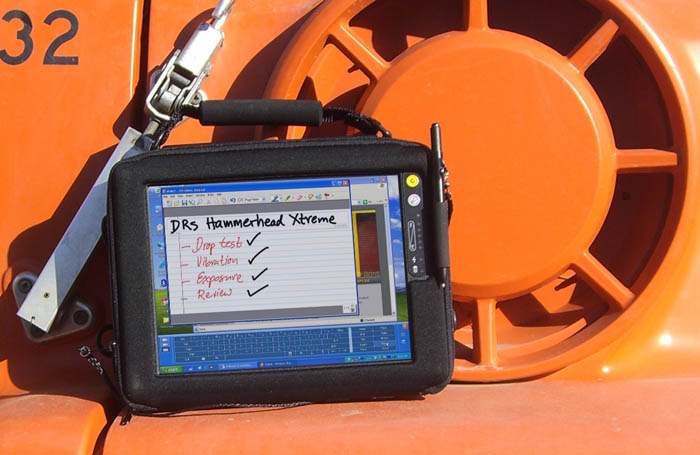
WalkAbout
Almost anyone who has been following the rugged mobile computer industry is probably familiar with the WalkAbout Hammerhead, the ultra-rugged pen computer milled from a solid block of metal. It is one of those timeless designs that came out right just from the start, and there never was a reason to change the basic design of this truly marvelous example of thoughful, task-oriented engineering.
True experts and historians of both pen computing and rugged mobile machines will also recall that the Hammerhead's DNA goes way back to the very dawn of pen computing, all the way to a company called
Tusk, circa 1990. The Tusk people created a machine called the "All Terrain Supertablet," a rugged slate that received positive reviews, but got caught up in the, how shall I put it, "controversy" around pen computing in the early 1990s. Well, some of the key people from Tusk became the driving force behind WalkAbout which got started in 1990. WalkAbout set up shop in West Palm Beach, Florida and operated as a privately held company for a good many years, mostly serving the utilities industry. Having the benefit of considerable experience in the early trials and tribulations of pen slates, the company quietly set about creating a new generation of machines that would make the slate computer dream real while avoiding earlier pitfalls such as hype, unrealistic expectations, reliance on handwriting recognition and technology that was not yet up to the task at hand.
Creating a true rugged pen computer
But making the pen computer dream real is just what they did, this time strictly focusing on vertical and industrial markets where solid engineering and ruggedness mattered most as opposed to catering to the fickle consumer space
(and press) with its utopian demands. That was in the mid 1990s when we had just gotten going with Pen Computing Magazine. In those days we often had "rugged" computers in our lab that were anything but. Some were like science projects gone bad. The better ones at times felt solid as if they had been milled from a solid block of metal. Well, the folks at WalkAbout did better. Their original Hammerhead was milled from a solid block of metal. A solid block of aircraft-grade Aluminum to be precise. The design was deceptively simple, like that of most good tools created for a job.
In those days Intel made 486 chips and Cyrix was still around. So the first Hammerhead we laid
our hands on was the 586, so named after its Cyrix 586 processor that steamed ahead at a then impressive 100MHz. No fan was needed and so the Hammerhead was totally sealed. There weren't any ports at all, or so it seemed. In fact, the Hammerhead combined connectivity into a single point of contact, that linked to a brilliantly conceived port replicator which doubled up as a desk stand. Despite its modest size (11 x 7.75 x 1.5 inches), the Hammerhead had a highly readable 9.4-inch display--huge at the time--and an active Wacom digitizer. And to top it all off, this miracle of design weighed in at a laughably light weight of just four pounds. And as if to rub it in, WalkAbout also shipped the Hammerhead
with what was by far the best custom-designed carry case we'd ever seen. In fact, over ten years later almost everyone is now using that form-fitting design.
Technological advancement
The Hammerhead computer was well received and WalkAbout quietly grew as a company, placing many thousands of machines in the field. While there obviously was no need to change the design, the little Cyrix chip gave way to a 233 MHz Pentium and a few years later to a Pentium III, conservatively
clocked at 400MHz. The Hammerhead 3 had a bigger screen, 10.4 inches, and you could get it either with a transmissive or transflective LCD. That model did well in the early years of the new millennium, but the ongoing processor wars quickly necessitated yet another generation of Hammerhead--the seventh--which was also the beginning of the Hammerhead platform
speparating into different models. Specifically, the 7th gen Hammerhead split into a value-oriented base RT model with a magnesium body and an ultra-rugged, fully decked-out XRT model with the traditional aluminum case. The 7th gen was also the first to undergo a mild redesign that added a dash of elegance to the traditionally functional, purposeful body of the Hammerhead. Power came from an 800 or 933MHz version of the Pentium M processor.
Walkabout becomes part of DRS Tactical
In June of 2005, WalkAbout Computers, Inc. was purchased by DRS Technologies, Inc., a worldwide provider of leading edge products and services to defense, government intelligence and commercial customers. Focusing on defense technology, DRS develops and manufactures a variety of mission critical systems. WalkAbout thus joined a number of other smaller rugged equipment manufacturers that were either purchased by financial holding companies for future sale, or incorporated into much larger conglomerates.
The 8th generation Hammerheads
This merger was obviously a happy one as it produced an impressive 8th generation of Hammerheads. As before, the line includes a "base" model, now just called the Hammerhead, and a top-of-the-line model, now called the Hammerhead Xtreme. There's actually a third model in the Hammerhead line now, and that is the Hammerhead MRT. MRT stands for "Military Rugged Tablet." It's a Hammerhead, but one very specifically designed for military markets with their different requirements. It's larger and heavier than the standard Hammerheads. In essence, the MRT merges WalkAbout and DRS heritage into a new and unique product for military and industrial applications.
The Hammerhead Xtreme
We're finally getting to the Hammerhead Xtreme. If anyone expected a radical redesign under the new ownership, they can rest easier. The basic Hammerhead design stays as is as there was absolutely no reason to mess with it. In fact, the tagline we used for our last full Hammerhead review, that of a 933MHz 7th gen Hammerhead XRT, again applies to the new 8th gen machine: "WalkAbout improves a near perfect rugged slate computer." And we concluded, "Anyone in the market for one of the toughest computers around, one that has been field-proven for almost ten years, and one that is unlikely to ever let you down, contact WalkAbout." Quite an endorsement from our jaded team.
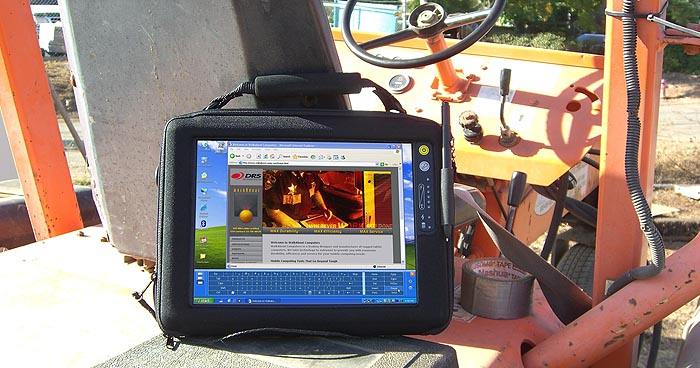
So what could DRS Tactical's WalkAbout team do as an encore? Well, the basics remain the same. The Hammerhead Xtreme still looks like a solid block of metal with a screen. In the case of the Xtreme, the housing indeed starts as a solid block of 6061-T6 aluminum, with 6061 defining the type of aluminum and T6 the heat-treating process. The basic body has a footprint of 10.5 x 8.25 inches and is 1.6 inches thick. On our scale, the Xtreme weighed 5.1 pounds, a bit heavier than the listed weight of 4.7 pounds. However, given that consumer laptops often weigh ten pounds and more, the fact that a nearly indestructible ultra-rugged slate computer made almost entirely of aluminum weighs half that much is amazing. Also, note that aluminum is heavier than magnesium, hence the weight difference between the standard Hammerhead and the Xtreme model.
A tool for the job
While this latest Hammerhead is no longer quite as industrial looking as the original models, it remains a tool for the job. It's all black, with a powdercoat finish that is just rough enough to provide a good grip. All edges and corners are rounded so that the unit is easy to hold. There is just enough space on all four sides so that you can hold the computer with both hands without your thumbs obliterating part of the display.

All rugged machines have their ports sealed to some extent, but it's logical that any port always represents a possible point of failure. In order to provide maximum ruggedness and protection, the Xtreme reduces potential weakspots to a minimum. There is a single USB port on the right side of the unit. On the left you find an RJ45 jack for Ethernet and a heavy-duty powerjack. That's it for the outside. Inside there's the FlexSpace OEM socket and an internal USB 2.0 port. All additional connectivity is via an optional docking station that connects to the back of the machine. Through it you get up to three serial ports, SVGA video, another USB port, an EPP parallel port, and a keyboard connector.
Controls are equally sparse and minimal. Though our Xtreme came with the Windows XP Tablet PC Edition 2005, the Hammerhead does not have the usual complement of Tablet PC hardware controls. Instead, there is a single information/control bar along the upper right of the machine. It contains an on/off button, a Windows Ctrl-Alt-Del button, a battery gauge consisting of five bright lights, a hard disk access light, and one that indicates charging status.
Technological updates
Under the hood, things have changed, but not by that much. The 800 and 933 MHz M processors have given way to a Centrino 1.1GHz chip, the 855GME chipset and a 400MHz system bus, adding some extra speed. Memory has been doubled from 256/512MB to 512/1024MB. The hard disk, likewise, is larger. Instead of a 20 or 40GB disk you now have the choice of a RHoS-compliant Hitachi TravelStar with either 40 or a 60GB capacity. Disks are of the 1.8-inch variety and, of course, shock-mounted. And interestingly so: the disk is mounted directly onto a thick aluminum cover, so that the rubber seal of the cover additionally acts as shock absorption.
Are the tech updates enough in this era of Intel Core Solo and Duo processors and the next generation of the ever more resource-intensive Windows OS, Vista, looming on the horizon? For most tasks at hand, yes. And compared to many other field-proven rugged machines with long histories, yes. But progress is so rapid these days that some will wish for a more radical update.
Displays
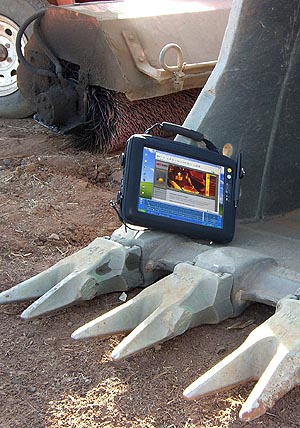 Display size remains at 10.4 inches and DRS offers a variety of display technologies for different working environments. For indoors, you may consider either the SVGA (800 x 600 pixels) or XGA (1024 x 768 pixels) transmissive LCD for its brightness. For outdoor use there is a reflective XGA screen that works best in direct sunlight, and also a transflective "All-Vis" SVGA display as a compromise for indoor and outdoor use.
Display size remains at 10.4 inches and DRS offers a variety of display technologies for different working environments. For indoors, you may consider either the SVGA (800 x 600 pixels) or XGA (1024 x 768 pixels) transmissive LCD for its brightness. For outdoor use there is a reflective XGA screen that works best in direct sunlight, and also a transflective "All-Vis" SVGA display as a compromise for indoor and outdoor use.
Do make sure you pick the right screen technology for your application! In general, nothing beats a bright transmissive screen IF most of your work is done indoors. Our review unit had the front-lit XGA reflective screen. If you remember the earliest iPAQ Pocket PC, you know how this kind of screen works: It provides good contrast even in direct sunlight - in fact the bright the better - and offers acceptable readability indoors. However, since it is reflective, the illumination must come from the front, via a light tube mounted along the top bezel of the screen. If you hold the screen at an angle you can see the light source and it can glare the display. The transflective display merges transmissive and reflective technologies and offers a decent compromise, but only for those who can accept the lower SVGA 800 x 600 resolution that has become marginal for many of today's screen-intensive applications.
Do not expect any of the brilliance of today's commercial notebook screens in a machine like the Hammerhead. The reflective LCD with its somewhat annoying frontlight seemed more of an anachronism than we remembered. And the thick protective glass in front of the screen makes for an additional nuisance - a very pronounced parallax effect: since the tip of the pen is a good fraction of an inch away from the cursor on the LCD, the two seem far apart depending what angle you look at the display. Finally, those used to the incredible BOE Hydis display with its near-180 degree viewing angle in all directions, will find the much smaller viewing angle of this display quite limiting.
Digitizer
The digitizer is a Wacom proximity-sensing electromagnetic design with all the well-known pros and cons. It has been the digitizer industry standard for more years than we care to remember and rewards users with a sleek and light active pen that does not need a battery. The Hammerhead uses a customized version that can be tethered via a braided black fiber cord to the computer's protective case. Any other Wacom pen we had in the office worked just fine with it, and replacements no longer cost a fortune as they did in the early days of pen computing. The digitizer senses the tip of the pen from as far as half an inch away. During fast pen movements it lags behind a bit and along the edge the digitizer becomes imprecise. That can be a bit of a problem with the Hammerhead as the screen is framed tightly by the fairly thick bezel, so you can't "overrun" the edge of the screen and trick the cursor into going where you want it. Those who prefer a simple touch screen can order the Xtreme with it and the standard version of Windows XP Professional.
Wireless and GPS
As behooves a modern mobile computer, the Hammerhead offers various wireless communications options. It comes with Bluetooth and Intel's Centrino 802.11 a/b/g capability. An integrated "FlexSpace" allows various options such as GPRS data or an integrated Garmin GPS.
Power
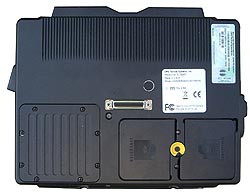 All of this is powered by WalkAbout's time-tested battery arrangement consisting of two externally mounted 10.8 Volt 20 Watt-Hour Li-Ion batteries. The batteries are securely held in place by an ingenious thumb wheel that you need to turn just right to remove a battery (see image on the right). The Hammerhead will operate fine with just one battery, but you cannot remove both at the same time without an external power source. A better solution would be somee short term backup battery, but one look inside the unit shows that's easier said than done.
All of this is powered by WalkAbout's time-tested battery arrangement consisting of two externally mounted 10.8 Volt 20 Watt-Hour Li-Ion batteries. The batteries are securely held in place by an ingenious thumb wheel that you need to turn just right to remove a battery (see image on the right). The Hammerhead will operate fine with just one battery, but you cannot remove both at the same time without an external power source. A better solution would be somee short term backup battery, but one look inside the unit shows that's easier said than done.
Do not plan on running the unit on just one battery for any length of time. 20 Watt-Hours isn't enough, and even 40 is marginal for a machine this powerful. This is one of the few areas where we'd like to see DRS make a significant change.
Heat
Since the unit is totally sealed, there is no fan and heat must be dissipated via the case itself that acts as a heat sink. As a result, the Hammerhead does get quite warm. WalkAbout did a remarkable job with thermal management, but packing this much power into a totally sealed unit with a fan is simply not possible without the unit running rather hot. Another reason to use it with its protective case whenever possible.
Protective case
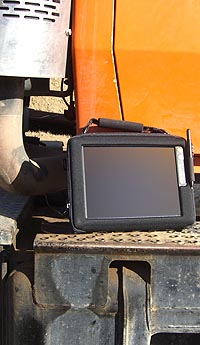 Speaking of the case, as stated above, it is one of our all-time favorites. It is a form-fitting affair that provides significant protection without adding hardly any bulk and extra size or weight at all. You open it with a zipper, it has handle clips on three sides so that you can carry it the way you want, and it has cutouts for all the unit's ports. The handle, again, is simple and functional rather than designed to impress. It's simply a tough, woven material strap with a dense roll of foam around it as a handle. That makes for comfortable carrying of the already rather light Hammerhead. The pen can be tethered to a zipper and there is a loop to securely park the pen in. This case is as close to perfect as it gets. And you don't even have to take it off to dock the machine.
Speaking of the case, as stated above, it is one of our all-time favorites. It is a form-fitting affair that provides significant protection without adding hardly any bulk and extra size or weight at all. You open it with a zipper, it has handle clips on three sides so that you can carry it the way you want, and it has cutouts for all the unit's ports. The handle, again, is simple and functional rather than designed to impress. It's simply a tough, woven material strap with a dense roll of foam around it as a handle. That makes for comfortable carrying of the already rather light Hammerhead. The pen can be tethered to a zipper and there is a loop to securely park the pen in. This case is as close to perfect as it gets. And you don't even have to take it off to dock the machine.
Environmental
As far as environmental protection goes, the Hammerhead Xtreme is, well, extreme. It's sealed to IP67 specification where the 6 stands for total protection against dust and the 7 for protection against immersion in water. The Xtreme doesn't have rubber bumpers, so it needs to be in its protective case to pass the 4-foot drop test. The operating temperature range is five to 140 degrees Fahrenheit. For use in extra-cold climates an optional heater package reduces the lower limit to -4 degrees Fahrenheit. The machine is also EMI/EMC protected according to FCC part 15 (United States EMC regulation for unlicensed personal communication service devices) and CISPR 22 A, which defines the conducted emissions requirements and testing of IT equipment. DRS also supplies vibration protection data as well as other regulatory approvals.
Summary
It's rare to come across a computer that was conceived for a very specific purpose, and then stays true to that concept for well over a decade. Styles come and go, yet no one will ever mistake a Hammerhead computer for anything else. And, given how the design was perfect from the start, it may well live on for many years to come, always, of course, updated with the latest available and practical technology. Being part of DRS Tactical will likely open many new markets and opportunities for the Hammerhead, and it should be interesting to see how that will affect this remarkable computer. High on our wishlist would be more readable screens and a bigger battery.
As is, this latest generation Hammerhead remains the perfect tool for rugged computing jobs in fields such as utilities, public safety, construction, manufacturing, military and so on.
– Conrad H. Blickenstorfer
WalkAbout Hammerhead Xtreme Specs
| Type |
Rugged Tablet PC slate
|
| Processor |
Intel Pentium M 1.1GHz |
| OS |
Windows XP Professional Tablet PC Edition |
| Memory |
512MB expandable to 1024MB |
| Display |
10.4" XGA (800 x 600 or 1024 x 768) All-Vis TFT |
| Digitizer/Pens |
Wacom/1 |
| Keyboard |
external option |
| Storage |
40 or 60 GB hard disk |
| Size |
10.5" x 8.25" x 1.6" |
| Weight |
5.1 pounds incl. battery pack |
| Power |
2x20 WHr Lithium-Ion |
| Communication |
Variety via port replicator |
| Interface |
1 USB 2.0, RJ45, various modules |
| Price |
inquire |
| Contact |
WalkAbout Computerwww.drs-ts.com |
|



